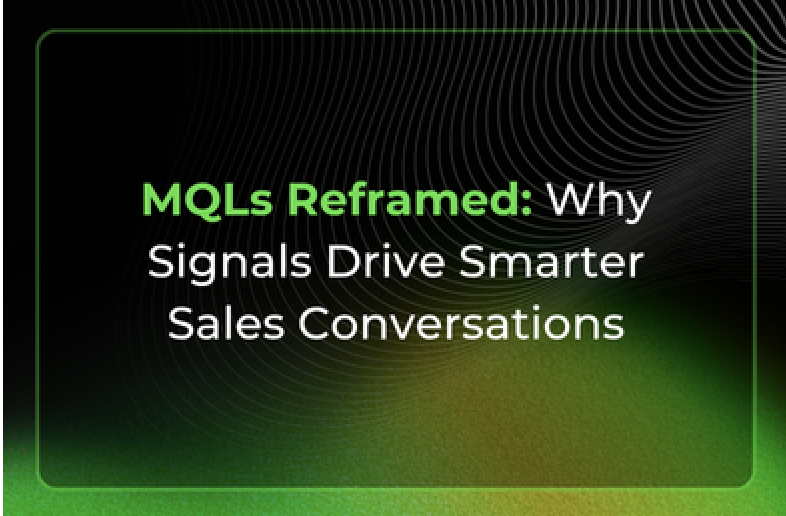MQLs Reframed: Why Signals Drive Smarter Sales Conversations
Published on:
October 8, 2025
Updated on:
November 24, 2025
The phrase has been circulating in sales and marketing circles for years, but is it really true? HubSpot reports that 79% of MQLs never convert to sales, with some assessments putting the figure as low as 1%. Or are MQLs simply evolving into something richer and more dynamic, shaped by signals that give sellers a clearer picture of buyer intent?


.png)
Let’s dive deep into how buying behaviour has shifted and how signals have become more important than ever.
The First Step Is ICP Alignment
It’s easy to assume every account on a target list is a perfect fit. One company had identified 3,000 “ideal” accounts, but when filtered properly, only half of them could actually buy their solution.
If sales had chased all 3,000, every second conversation would have been irrelevant. And irrelevant leads erode seller confidence fast. By sharpening the ICP and filtering signals against it, suddenly those signals carried weight and sellers knew each one was worth pursuing.
Wasting cycles on the wrong signals burns times and derails revenue, which is why ICP clarity is non-negotiable.
The World of Signals
Once you know your ICP, the next step is making sense of signals. And not all signals are created equal.
- Third-party signals: These are widely available and, yes, they take resource to use. But even with the effort involved, they’re miles better than randomly selecting cold accounts. At least they give you a head start.
- Second-party signals: A step up. They’re more relevant, often sourced from partnerships or communities, and give you more to work with.
- First-party signals: The holy grail. Because when the data is yours, and only yours, you’re the one shaping the narrative with your buyers before your competitors even get a look in.
These are the triggers that show when a business is under pressure to act. If a company is restructuring or making high-stakes announcements, the right solution, positioned correctly, can land with perfect timing. It’s about being there at the right moment with the right message.
Keep It Simple for Your Sellers
One of the biggest mistakes teams make is overloading sellers with too much data and no direction.
The best playbooks are simple. A clear trigger → action.
- A signal comes in.
- The rep knows what to do.
- They respond with urgency.
- And they lead with value, not a hard sell.
You don’t want sellers stuck in “blunt instrument” mode, asking: “Are you ready for a demo?” That’s not helpful.
What works is equipping sellers with toolkits that let them educate. If a prospect interacts with content that speaks directly to their pain point, that’s the perfect time to follow up. Not with pressure, but with something insightful, something they can share with colleagues.
That’s how you create those dark social moments — the untrackable conversations where someone says, “Hey, did you know we’re losing £100k every month not fixing this?” That’s influence you can’t buy with ads.
The Measured Impact of Signals
Implementing a signal-based strategy didn’t magically double or triple win rates overnight. But what Staffbase and other companies saw consistently was:
- 25–35% increase in outbound conversion rates. Instead of pitching generically, sellers came with undeniable context. We call this warm outbound. Backed by clear, relevant signals, it simply landed better than cold outreach.
- Shorter sales cycles. With signals pointing to the right people and moments, sellers could multi-thread earlier and skip entire phases of discovery.
- Higher win rates. Harder to quantify in isolation, but improved significantly when combined with shorter cycles and warmer conversations.
Demand Building Is a Long Game
It’s tempting to think signals mean instant wins. But building demand takes time, thought, and intelligence. Signals give you an edge, but they’re not magic. You still need to nurture, educate, and gradually build trust with buyers.
Content plays such a critical role here. Every touchpoint should make your sales team excited to follow up and able to position themselves as helpful advisors.
Because the more value you give upfront, the more you earn the right to eventually ask for a meeting.
So, are MQLs dead?
Not really. What’s happening is a reframing.
They only mean something when intent is put into context. Signals turn that intent into a common language that both marketing and sales can act on.
When sellers are supported with the right context, when they understand not just who to reach out to but why, they stop chasing random activity and start converting real intent into revenue.
To see what this shift looks like in practice, explore our new Marketing Under Attack webinar with Daniel Farkas, Global CRO and SaaS Growth Strategist, along with Orbital X Co-founders, James Ford and Stuart Dale.




